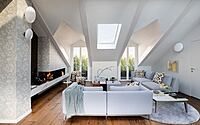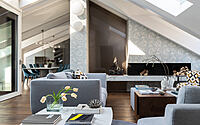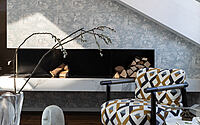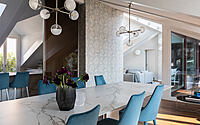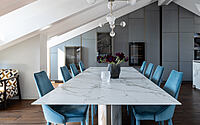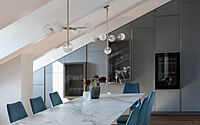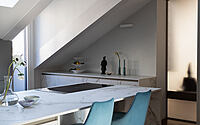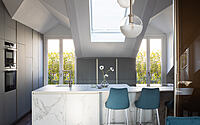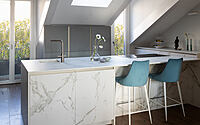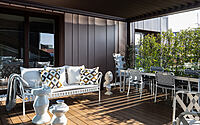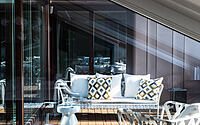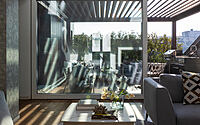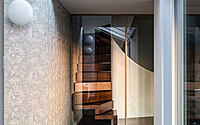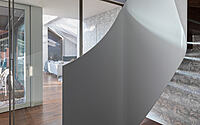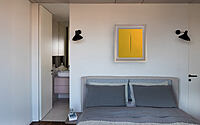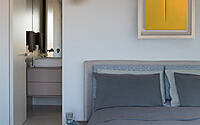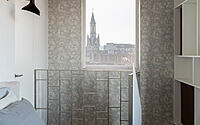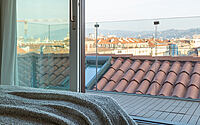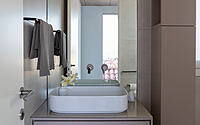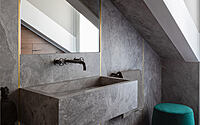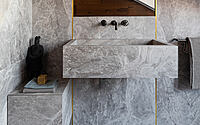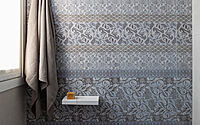M51 by Icona Architetti Associati
M51 is a beautiful attic apartment located in Turin, Italy, redesigned in 2020 by Icona Architetti Associati.
Description
iaa_M 51 is a residential project, obtained by recovering and expanding the attic level of an elegant 1930s building, located in the Porta Susa area, and transforming it into a ‘cozy home for a family.
Thanks to the freedom with which it was able to experiment, adopting the entire toolkit of its knowledge, M51 fully manifests the stylistic signature of Icona, the epitome of its aesthetic.
M51 is located in the Porta Susa area, a stone’s throw from the San Paolo skyscraper and Cit Turin, in a neighborhood characterized by a sequence of elegant buildings from the 1930s and some remarkable examples of Turin’s Art Nouveau. At the turn of the millennium, this part of the city acquired new nuances, transforming into a commercial and office hub that grew up in the shadow of Renzo Piano’s building and close to the historic center.
In 2020, Icona ventured to reconfigure one of these historic multi-story buildings into a comfortable and well-maintained representative residence overlooking the rooftops of Turin.
The initial project was supposed to be limited to a pied-à-terre for the cosmopolitan clients: during the meetings, however, more complex and deeper needs and desires emerged, which had not been focused on at first.
By virtue of the fruitful dialectic between designers and clients, the new housing purposes became attuned to the extraordinary potential of the spaces: and this is how a minimal intervention became a major design challenge.
Icona took advantage of the ample freedom of maneuver and the trust granted to experiment and explore all the creative possibilities of the project, both in terms of volumes and materials: the residence can be considered to all intents and purposes a kind of philosophical manifesto of Icona, the epitome of its aesthetic.
Architecturally, the rooms on the top floor of the block of flats are completely transformed and remodeled, increasing their heights and transparency, always seeking maximum natural light. The apartment is developed, as if in an embrace, around the large panoramic terrace-deck, separated from the interior by a large glass wall. The heights have been made more generous thanks to the new glulam roof, covered with pigmented painted sheet metal slats, which fits perfectly into the original aesthetics of the period building. To obviate the humdrum nature of the dark, deep spaces, a sequence of more than twenty dormers embroiders the perimeter of the residence: like telescopes of light projecting outward, they are each fitted with a small balcony, which captures an additional portion of the panorama.
The dormers have been aligned with the original forometries of the building, allowing the new envelope to avoid any visual discontinuity with the body of the block of flats, and indeed giving the impression of having been there all along.
Finally, the manor turret is an exclamation point on the horizon: it is a volumetric addition, also clad in the same burnished metal covering, that stands out from the top of the building and is generated by the extrusion of the stairwell. The turret functions as a bedroom but also as a privileged vantage point over the Turinese hill and the city.
Considering the plan of the project, the strategic separation of the quiet area from the living area is evident, achieved by orienting the spaces wisely. The living area is composed of the seamless alternation of the kitchen, dining, living and terrace. All these spaces are distributed along the axis of the building’s spine wall: a vestigial element around which the entire ecosystem of conviviality is organized.
The power of the plug wall has been mitigated by covering it with a cerulean-colored wallpaper, which lightens its thickness, making it almost impalpable. At the height of the kitchen, the septum is interrupted, replaced by elegant retractable glass windows that can isolate the kitchen from the dining room if necessary. A large sugar-paper-colored fitted wall intersects the plug axis transversally, occupying the wall and following the trend of the pitches: the cabinet is designed with a pleasant play of volumes that manages to absorb misalignments.
The whole of the living areas was conceived in a comprehensive, holistic way, in the pursuit of radical flexibility: it was essential to ensure the absolute modularity of these spaces through the use of movable and transparent walls, both between interior and exterior and between interior infraspaces.
The convivial rooms thus become the stage for a non-unique and non-definitive experience, the place of a fluid living, experienced with different spirit and attitude, pandering to the variance of the seasons or the evolution of habits.
The mirrored part of the apartment is reserved for the quiet zone: two rooms for the children, one for guests, a playroom, a semi-independent mini-apartment for domestic helpers, the service areas. A paneling covered in blue-gray velvet wraps the central “core” of the apartment and the building and frames the entrance to the dwelling.
The composite articulation of spaces is matched by the exceptional maniacal attention to detail: the level of customization is maximum. Almost all of the contents in the house were either designed specifically for it, or modified and customized in its function: the chairs, lamps, furniture, fabrics, stained glass, and window frames are all, in one way or another, altered and optimized by the designers’ modifications and interpolations.
The connecting staircase between the main floor and the turret, for example, is a sculptural work imagined and designed by Icona in every aspect as a true contemporary work.
Designed in carpentry, each step is different from the other and all together develop the slender sine wave that reaches the upper level. A shutter separates each step, making it appear suspended in the air: this lightens the mass of the wooden material, projecting onto the decorated wall of the stairwell very suggestive plays of penumbra. The supporting element of this structure is the white painted iron sheet parapet, which wraps like a silk ribbon the development of the staircase.
The imposing marble table is also an example of the architects’ aptitude for design: together with the freestanding kitchen cabinets of the same material, it lends extraordinary elegance and luminosity to the adjoining rooms. The essential line of its top and the sharp geometry of the supports are a perfect match for the soft, retro forms of the seating.
In general, there is precise and meticulous attention in the balances and counterpoints between forms and colors.
The cool tones of the furniture and finishes (the marbles, the upholstery, the colors of the fabrics and wallpapers), for example, are amply offset with the warm-toned, textured, lived-in parquet flooring that occupies the horizontal plane of the residence connecting all the rooms.
M51 is an incredibly well-thought-out, designed dwelling, shaped with accuracy and depth. Nothing has been left to chance in this choral project that acquires a unique identity. Family life, the mixture of selected materials come together in multifaceted environments.
The contemporary nature of the selected materials and the emphasis achieved thanks to the large windows harboring natural light mixes with the harmonious twentieth-century breath of the building and the neighborhood.
A house-figure, which encapsulates the meaning of architecture for Icona.
Photography by Monica Spezia
Visit Icona Architetti Associati
- by Matt Watts